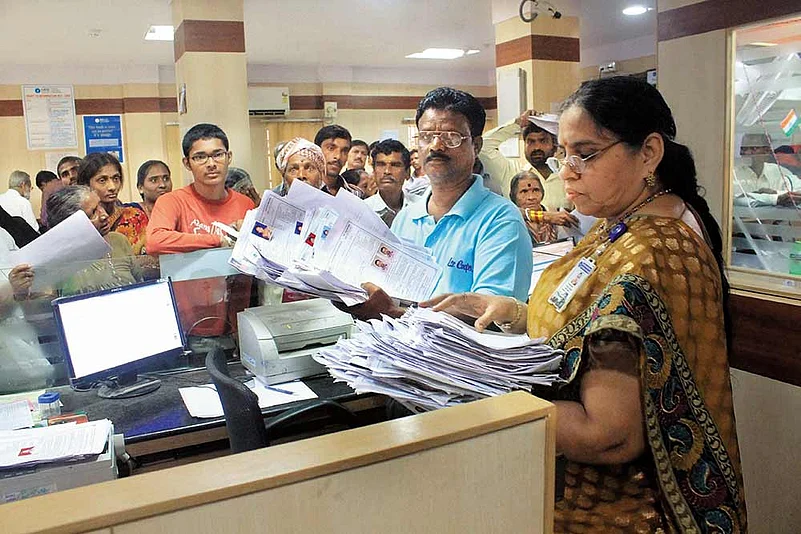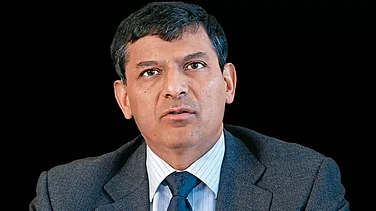Nilekani’s Way Forward
How India Wants Its Money And Why Cashless Transaction Is Far From Reality
With 100 million users in a country of 1,350 million, cashlessness of the digital kind is a long way home

Some recommendations of the RBI-appointed Nandan Nilekani committee on digital payments:
- No-KYC wallets with a maximum value of Rs 2,000 and monthly spending capped at Rs 10,000
- Digital payments by citizens to all -government and public sector agencies
- Removal of all charges on digital -payment transactions
- Extension of RuPay and BHIM UPI -overseas to facilitate easy remittance
***
Prime Minister Narendra Modi’s ambitious project—JAM (Jan-Aadhaar-Mobile)—got a shot in arm recently when the five-member panel under Aadhaar architect Nandan Nilekani, formed by the Reserve Bank of India, projected that per capita digital transactions in India are set to inc-rease from 22 in March 2019 to 220 by March 2022. The panel also said that the number of digital trans-action users in the country would rise from 100 million to 300 million over the next three years. The numbers may look pleasing, but the ground left uncovered is still huge in a country with a population of 1,350 million (as of June).
In its first tenure, the Modi government took a series of measures to force a shift to cashless transactions on the people—the Pradhan Mantri Jan Dhan Yojana (PMJDY) to bring more people into the banking system, demonetisation to reduce disposable cash with people and introducing direct benefit transfer (DBT) to bank accounts for around two dozen government schemes. But cash continues to rule the roost. Kalpana, who hails from West Bengal and works as a maid in Noida, Uttar Pradesh, has a Jan Dhan account with a RuPay card, but doesn’t know how to use an ATM. She has an Aadhaar number, but her address registered with the Unique Identification Authority of India is a Bengal one—with no document to prove she is a resident of Noida, she cannot get her address changed. Here mobile is not a smartphone. Clearly, the JAM trinity has failed her.
“My employers pay me in cash, which is what I also prefer,” says Kalpana. “To use my account or ATM, I have to dep-end on a bank official or an acquaintance.” She adds it would help many like her if the ATM machines used symbols besides text for users who can’t read. Even in her Bengal village, withdrawal of money is at mercy of ‘banking correspondents’ who decide when to visit. She says she would be open to cashless transaction if it were made simpler.

Account-holder in Patna
Kalpana is a beneficiary of the PMJDY, which was launched in August 2014. Under this financial inclusion prog-ramme, Jan Dhan accounts were ope-ned for citizens in the age group of 20-65 years. These zero-balance bank accounts offer an overdraft facility of upto Rs 10,000 after six months. Until May 29, 357.49 million Jan Dhan acco-unts had been opened in both private and public banks, with 77 per cent of beneficiaries getting RuPay cards.
Since January 2, the total amount in Jan Dhan accounts has seen a phenomenal growth from Rs 87,03,342.18 lakh to Rs 98,43,433.31 lakh as of May 22. This means deposits amounting to Rs 1,140,091.13 lakh were made during this period. But, within a week since the Lok Sabha results were declared on May 23, the total amount decreased by Rs 11,436.3 lakh. What drove this hike in Jan Dhan deposits during election season is a mystery whose answer is neither with the finance ministry nor the banking officials. Does it mean that the poorest sections in the country had suddenly started depositing money in their accounts during that period, -giving a push to cashless India?
“Over half of the Jan Dhan accounts have not witnessed any transaction from the beneficiaries as per our -est-imates,” says a senior Punjab National Bank official, who didn’t wish to be named. “In fact, during my field visits I found that many of the beneficiaries were not even aware of how to use the overdraft facilities and transactions.” Adding that the relative popul-arity of cashless transactions in urban centres is mainly due to the cash-back offers by mobile wallets such as Paytm, he says, “If the cash-backs are stopped, I am sure there might be a fall in digital transactions.”
According to this bank official, the Indian Post Payment Bank is “one of the best ways to reach out to the lowest rungs of the economy for promoting digital transactions”. However, he adds: “Not enough is being done. They have a network of people who can be held responsible, yet the government is not focusing on strengthening them. The private sector would never be int-erested in reaching the lowest rungs, hence the onus to find a solution is on the government if it is really serious about cashless India.”
Five years since Jan Dhan was launched, the same problems have persisted: not enough PoS terminals for transactions, poor internet conn-ectivity, and lack of online banking and digital transaction skills. “When we say ‘cashless economy’, we are not really aiming at 100 per cent cashless tran-sactions,” says a senior finance ministry official on the condition of anonymity. “Even if we are able to achieve 50 per cent cashless transacti-ons in India, it would be a big feat. The government is working on the problems and there has been an improvement. We hope connectivity issues too would be resolved with the rollout of 5G over the next year or two.”
According to the ministry official, the main challenges to cashless economy would come from villages, small towns and untapped markets in urban India. He adds that the Nilekani panel’s recommendation that banks need to ensure that no user is more than 5 km away from a banking access point is a good idea. The PNB official, however, points out that it is impossible for banks to increase infrastructure and says that is the reason why the post office payment banks can be the best option. “The fee charged by banking correspondents for financial transactions in rural areas is also seen as a burden, but government officials don’t realise this,” says the banker.
The Nilekani report says that DBT beneficiaries withdraw the money transferred into their bank almost imm-ediately and spend it in cash. Queues of beneficiaries of pension schemes and the Mahatma Gandhi National Rural Employment Guarantee Act (MGNREGA), involving transfers of the citizen’s monetary entitlement from the government, waiting long hours to withdraw from their own acc-ounts—and thereby often losing a day’s income—is a common sight in rural branches across the country. With the bottom of India’s economic pyramid still grappling with limited resources for adopting digitised lifestyles, it won’t be easy for Modi 2.0 to achieve the cashless dream.

























